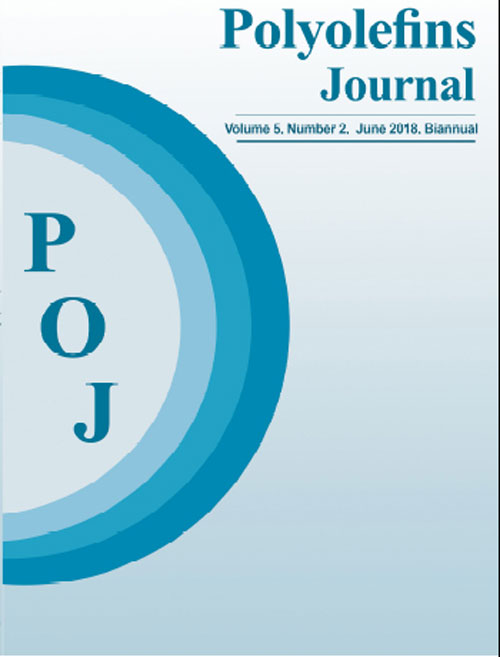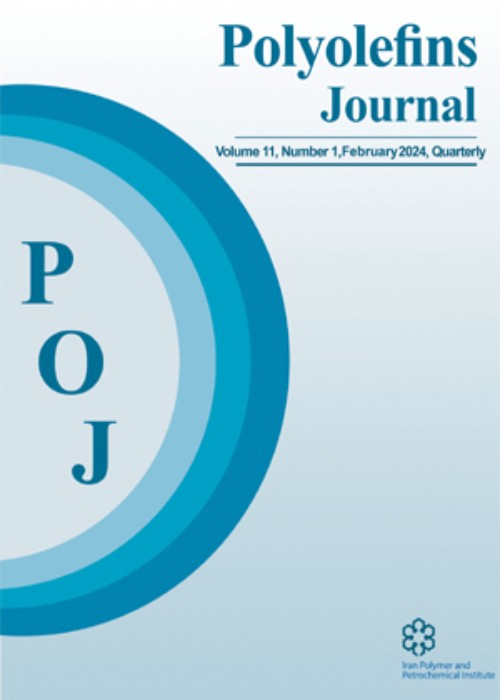فهرست مطالب

Polyolefins Journal
Volume:5 Issue: 2, Spring 2018
- تاریخ انتشار: 1397/03/30
- تعداد عناوین: 6
-
-
Pages 97-109In this study, the response surface methodology (RSM) based on the central composite design (CCD) was used to optimize the preparation condition of polypropylene-grafted maleic anhydride (PP-g-MA) microporous membrane by thermally-induced phase separation (TIPS) method. A mixture of dibutyl phthalate (DBP) and dioctyl phthalate (DOP) was used as diluent. The effect of polymer composition and quenching bath temperature on the morphology and performance of the fabricated microporous membranes was investigated by using RSM. Analysis of variance (ANOVA) was used to determine which variables and interactions between variables had a significant effect on our responses. The ANOVA revealed that the bath temperature was the most significant variable associated with porosity and pure water flux responses and the polymer concentration was the most significant variable associated with tensile response. The obtained results also showed that with increasing the polymer concentration and decreasing the quenching bath temperature, the membrane porosity and pure water flux decreased, whereas the membrane tensile increased. The regression equations were reasonably validated and used to predict and optimize the performance of PP-g-MA membranes within the limits of the variables. Finally, the maximum responses (flux of 115.6 L/m2h, porosity of 62% and tensile of 1.6 MPa) were obtained under the following conditions: polymer concentration of 28.5 wt% and temperature of 329 K. Further, comparison of laboratory-made and commercial membranes in a membrane bioreactor (MBR) system showed that the rate of membrane fouling was decreased by 4.2 times.Keywords: Response surface methodology, thermally induced phase separation, polypropylene grafted maleic anhydride, membrane, morphology, MBR
-
Pages 111-123Gas phase polymerization of propylene was carried out in a semi-batch minireactor using a commercially supported ZieglerNatta (ZN) catalyst. The influence of variables including monomer partial pressure, external electron donor, reaction temperature and time on the particle morphology and size distribution was investigated. Generally, more uniform fragmentation and particle densities were obtained at lower reaction rates. Monomer partial pressure showed a significant role of particle size and its distribution, the higher the monomer partial pressure, the broader particle size distribution was obtained. Polymerization pressure had a significant role on the morphology of particles. Wider cracks and more porosity were resulted from the polymerizations at higher pressures. Furthermore, a broader particle size distribution was obtained from the polymerization at higher pressures. The particle size analysis revealed the monomer partial pressure as the most effective parameter on the distribution of particles. The SEM images showed that three different steps could be distinguished in the development of particle morphology within the particle, showing the initiation and development of cracks and appearance of fragments inside the particle.Keywords: Propylene polymerization, gas phase, mini, reactor, Ziegler, Natta, particle morphology
-
Pages 125-139This study presents methods for treating a kind of nanoclay and investigates the effects of methylaluminoxane (MAO) exposure time and or dodecylamine (DDA) reflux time on in-situ polymerization of ethylene in the presence of nanoclay and examines the morphology and properties of the prepared polyethylene/clay nanocomposites. The results revealed that by increasing MAO exposure time productivity decreased. Modification of nanoclay by NH3/MAO led to formation of exfoliated structures. In treatment with NH3/DDA, the change in reflux time resulted in different structures. SEM demonstrated that the morphology of the nanocomposites strongly depended on the modification method and treatment time. Dynamic mechanical analysis indicated that the elastic modulus of the nanocomposites increased by increasing MAO exposure time. The nanocomposites treated with different MAO exposure times showed similar thermal degradation behavior. The nanocomposite modified under the condition of 24 h DDA reflux time indicated the lowest thermal decomposition temperature due to poor dispersion of nanoclay in the synthesized nanocomposite. The nanocomposites modified by NH3/MAO had higher degree of crystallinity compared to those modified by NH3/DDA, which could be attributed to the difference in dispersion level of the modified clays. A relationship between the rheological properties, weight fraction and dispersion of modified nanoclay was observed. The findings showed that the modification condition had a significant influence on the morphology and properties of the synthesized nanocomposites.Keywords: in, Situ Polymerization, polyethylene, Nanoclay, Methylaluminoxane
-
Pages 141-151In this work, a series of polypropylene/polyvinyl butyral (PP/PVB) blends were prepared by melt-blending process, at PVB loadings 3 wt%, 10 wt%, and 30 wt%. The effects of PVB on crystallization behavior of PP were investigated by differential scanning calorimetry (DSC), and polarized optical microscopy (POM). The isothermal crystallization kinetics were analyzed by Avrami equations. It was found that the addition of PVB strikingly reduced the overall crystallization rate of PP. The POM results further indicated that the crystallization rate of PP/PVB was significantly reduced by reducing the nucleation density of PP with the addition of PVB. The fractured surface morphology of PP/PVB blends was characterized by scanning electron microscopy (SEM), and the results showed that the PVB was uniformly dispersed in the PP matrix as small spherical particles, with a good dispersion and dimensional stability.Keywords: PP, PVB blend, isothermal crystallization, nucleation density, morphology
-
Pages 153-156Since 1999, when Takuzo Aida proposed the preparation of high density polyethylene (HDPE) crystalline nanofibers through polymerization of ethylene by a Cp2 TiCl2 /MCM-41 catalyst, many researchers have published various papers on different aspects of the idea. The published researches show that the endeavors to polymerize other types of alpha olefins, especially propylene, to obtain polyolefins with crystalline nanofiberous morphology have not been successful and no one has reported such morphology for them. In the present article, a possible reason behind these observations is proposed. Comparing the direction of the growth of HDPE chains and isotactic polypropylene (iPP) helices to become appropriate for making polymer crystals shows that HDPE chains are able to form crystal unit cells without concerning upward or downward chain growth direction, while the growth direction of adjacent iPP chains might be responsible for unsuccessful synthesis of crystalline iPP nanofibers in confined channels of the mesoporous catalysts. iPP helices can crystallize beside each other only in the form of anticline isochiral helices.Keywords: HDPE crystalline nanofibers, iPP, crystal unit cell, helical chain
-
Pages 157-165Eight different zirconium phenoxyimine complexes were synthesized, characterized and tested as catalysts for ethylene polymerization. The phenoxyimine compounds were prepared by condensation of substituted salicylaldehydes with aliphatic and aromatic amines, the substituted salicylaldehydes from ortho substituted phenols and paraformaldehyde. The introduction of iodo substituents was achieved either by iodination of the aldehyde component followed by condensation with amines or the iodination of the aldehyde after the condensation with amines or the iodination via condensation with iodo substituted amines. Deprotonation of the hydroxy function of phenoxyimine compounds and reaction with zirconium tetrachloride gave mononuclear bis(phenoxyimine) zirconium complexes in good yields. These complexes were activated with methylaluminoxane (MAO) and applied for ethylene polymerization. The performances of the various catalysts were compared and structure-property-relationships were discussed.Keywords: Zirconium phenoxyimine complexes, catalytic ethylene polymerization, structure, property, relationship studies


